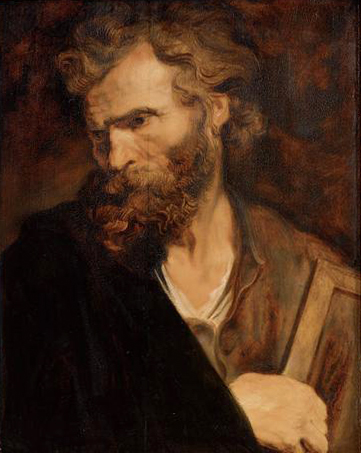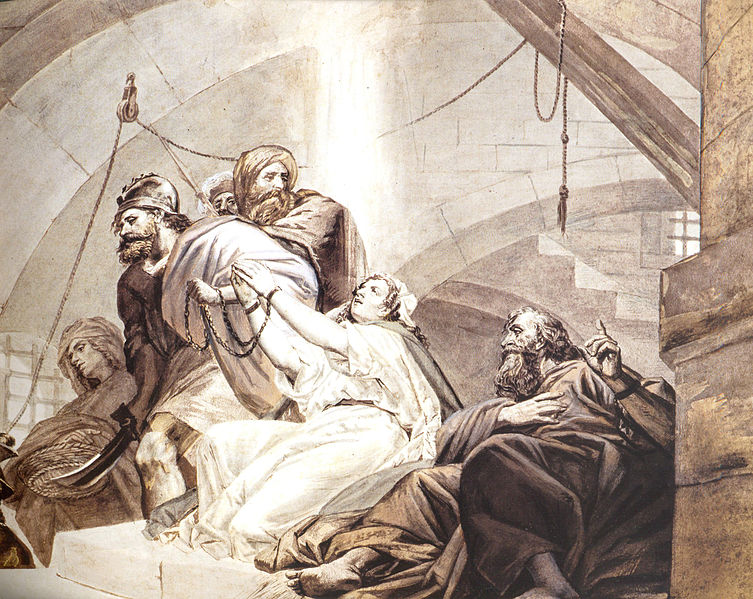<Back to Index>
- Apostle Judas Thaddaeus, 1st
Century
PAGE SPONSOR


Jude was one of the Twelve Apostles of Jesus. He is generally identified with Thaddeus, and is also variously called Jude of James, Jude Thaddaeus, Judas Thaddaeus or Lebbaeus. He is sometimes identified with Jude, "brother of Jesus", but is clearly distinguished from Judas Iscariot, another disciple, the betrayer of Jesus.
The Armenian Apostolic Church honors Thaddeus along with Saint Bartholomew as its patron saints. In the Roman Catholic Church he is the patron saint of desperate cases and lost causes.
Saint Jude's attribute is a club. He is also often shown
in icons with a flame around his head. This represents his
presence at Pentecost, when he received the Holy Spirit
with the other apostles. Another common attribute is Jude
holding an image of Jesus
Christ, in the image of Edessa. In some instances
he may be shown with a scroll or a book (the Epistle of
Jude) or holding a carpenter's rule.
Jude is clearly distinguished from Judas Iscariot, another disciple and later the betrayer of Jesus. Both "Jude" and "Judas" are translations of the name Ιούδας in the Greek original New Testament, which in turn is a Greek variant of Judah, a name which was common among Jews at the time. In most bibles in languages other than English and French, Jude and Judas are referred to by the same name.
"Jude of James" is only mentioned twice in the New Testament: in the lists of apostles in Luke 6:16 and Acts 1:13.
The name by which Luke calls the Apostle, "Jude of James" is ambiguous as to the relationship of Jude to this James. Though such a construction sometimes connotated a relationship of father and son, it has been traditionally interpreted as "Jude, brother of James" (Luke 6:16) though Protestants (for instance, the New International Version translation) usually identify him as "Jude son of James".
The Gospel of John also once mentions a disciple called "Judas not Iscariot" (John 14:22). This is often accepted to be the same person as the apostle Jude, though some scholars see the identification as uncertain.
In some Latin manuscripts of Matthew 10:3, he is called
Judas the Zealot.
In the comparable apostle-lists of Matthew 10:3 and Mark 3:18, Jude is omitted, but there is a Thaddeus (or in some manuscripts of Matthew 10:3, "Lebbaeus who was surnamed Thaddaeus") listed in his place. This has led many Christians since early times to harmonize the lists by positing a "Jude Thaddeus", known by either name. This is made plausible by the fact that "Thaddeus" seems to be a nickname (see Thaddeus).
A further complication is the fact that the name "Judas" was tarnished by Judas Iscariot. It has been argued that for this reason it is unsurprising that Mark and Matthew refer to him by an alternate name.
Some Biblical scholars reject this theory, however, holding that Jude and Thaddeus did not represent the same person. Scholars have proposed alternate theories to explain the discrepancy: an unrecorded replacement of one for the other during the ministry of Jesus because of apostasy or death; the possibility that "twelve" was a symbolic number and an estimation; or simply that the names were not recorded perfectly by the early church.
Thaddeus one of the twelve apostles is generally seen as a different person from Thaddeus of Edessa, one of the Seventy Disciples.
Opinion
is divided on whether Jude the apostle is the same as
Jude, brother of Jesus, who is mentioned in Mark 6:3
and Matthew 13:55-57,
and is the traditional author of the Epistle of Jude. Some
Catholics believe the two Judes are the same person,
while Protestants do not.
Tradition holds that Saint Jude preached the Gospel in Judea, Samaria, Idumaea, Syria, Mesopotamia and Libya. He is also said to have visited Beirut and Edessa, though the emissary of latter mission is also identified as Thaddeus of Edessa, one of the Seventy. The 14th century writer Nicephorus Callistus makes Jude the bridegroom at the wedding at Cana. The legend reports that St. Jude was born into a Jewish family in Paneas, a town in Galilee later rebuilt by the Romans and renamed Caesarea Philippi.
In all probability he spoke both Greek and Aramaic, like almost all of his contemporaries in that area, and was a farmer by trade. According to the legend, St. Jude was a son of Clopas and his wife Mary, a cousin of the Virgin Mary. Tradition has it that Jude's father, Clopas, was murdered because of his forthright and outspoken devotion to the risen Christ.
Although Saint Gregory the
Illuminator is credited as the "Apostle to the
Armenians", when he baptized King Tiridates III of Armenia
in 301, converting the Armenians, the Apostles Jude and Bartholomew are traditionally
believed to have been the first to bring Christianity to
Armenia, and are therefore venerated as the patron saints
of the Armenian Apostolic Church. Linked to this tradition
is the Saint Thaddeus Monastery (now in northern Iran) and
Saint Bartholomew Monastery (now in southeastern Turkey)
which were both constructed in what was then Armenia.
According to the tradition, Saint Jude suffered martyrdom about 65 AD in Beirut, in the Roman province of Syria, together with the apostle Simon the Zealot, with whom he is usually connected. The axe that he is often shown holding in pictures symbolizes the way in which he was killed. Their acts and martyrdom were recorded in an Acts of Simon and Jude that was among the collection of passions and legends traditionally associated with the legendary Abdias, bishop of Babylon, and said to have been translated into Latin by his disciple Tropaeus Africanus, according to the Golden Legend account of the saints.
Sometime after his death, Saint Jude's body was brought from Beirut to Rome and placed in a crypt in St. Peter's Basilica which was visited by many devotees. Now his bones are in the left transept of St. Peter's Basilica under the main altar of St. Joseph in one tomb with the remains of the apostle Simon the Zealot. According to another popular tradition, the remains of St. Jude were preserved in an Armenian monastery on an island in the northern part of Issyk - Kul Lake in Kyrgyzstan at least until the mid 15th century. Later legends either deny that the remains are preserved there or claim that they were moved to a yet more desolate stronghold in the Pamir Mountains.
Jude is traditionally depicted carrying the image of
Jesus in his hand or close to his chest, betokening the
legend of the Image of Edessa, recorded in apocryphal
correspondence between Jesus and Abgar which is reproduced
in Eusebius' History
Ecclesiastica, I, xiii. Eusebius relates that King Abgar of Edessa (now Şanlıurfa in
southeast Turkey) sent a letter to Jesus seeking a cure
for an illness afflicting him. With the letter he sent his
envoy Hannan, the keeper of the archives, offering
his own home city to Jesus as a safe dwelling place. The
envoy painted a likeness of Jesus with choice paints (or
alternatively, impressed with Abgar's faith, Jesus pressed
his face into a cloth and gave it to Hannan) to
take to Abgar with his answer. Upon seeing Jesus' image,
the king placed it with great honor in one of his palatial
houses. After Christ's execution, Thomas the Apostle sent
Jude to King Abgar and the king was cured. Astonished, he
converted to Christianity, along with many of the people
under his rule. Additionally, St. Jude is often depicted
with a flame above his head, representing his presence at
Pentecost, when he was said to have received the Holy
Spirit with the other apostles.
According to tradition, after his martyrdom, pilgrims came to his grave to pray and many of them, experienced the powerful intercessions of St. Jude. Thus the title, 'The Saint for the Hopeless and the Despaired'. St. Bridget of Sweden & St. Bernard had visions from God asking each to accept St. Jude as 'The Patron Saint of the Impossible'.
The Order of Preachers (the Dominicans) began working in present day Armenia soon after their founding in 1216. There was a substantial devotion to St. Jude in this area at that time, by both Roman Catholic and Orthodox Christians. This lasted until persecution drove Christians from the area in the 18th century. Devotion to Saint Jude began again in earnest in the 19th century, starting in Italy and Spain, spreading to South America, and finally to the United States (starting in the area around Chicago) owing to the influence of the Claretians and the Dominicans in the 1920s.
Saint Jude is the patron saint of the Chicago Police Department and of Clube de Regatas do Flamengo (a soccer team in Rio de Janeiro, Brazil). His other patronages include desperate situations and hospitals. One of his namesakes is St. Jude Children's Research Hospital in Memphis, Tennessee, which has helped many children with terminal illnesses and their families since its founding in 1962. His feast day is October 28 (Roman Catholic Church, the Anglican Communion and Lutheran Church) and June 19 (Eastern Orthodox Church).
A common Roman Catholic prayer to St Jude is:
| “ | O most holy apostle, Saint Jude, faithful servant and friend of Jesus, the Church honoureth and invoketh thee universally, as the patron of hopeless cases, and of things almost despaired of. Pray for me, who am so miserable. Make use, I implore thee, of that particular privilege accorded to thee, to bring visible and speedy help where help was almost despaired of. Come to mine assistance in this great need, that I may receive the consolation and succor of Heaven in all my necessities, tribulations, and sufferings, particularly (here make your request) and that I may praise God with thee and all the elect throughout eternity. I promise thee, O blessed Jude, to be ever mindful of this great favour, to always honour thee as my special and powerful patron, and to gratefully encourage devotion to thee. Amen. | ” |
An alternative prayer:
| “ | May the Sacred Heart of Jesus be adored, glorified, loved and preserved now and forever. Sacred Heart of Jesus have mercy on us, Saint Jude worker of Miracles, pray for us, Saint Jude helper and keeper of the hopeless, pray for us, Thank you Saint Jude. | ” |
In some daily newspapers people will place classified ads seeking the
aid of St. Jude or thanking him for his intercession. It
is also common to post prayer requests to St Jude on
Catholic prayer request websites.